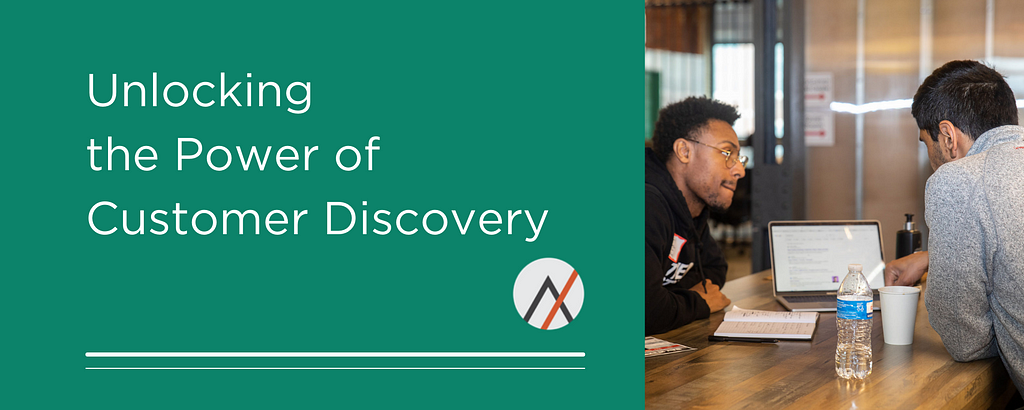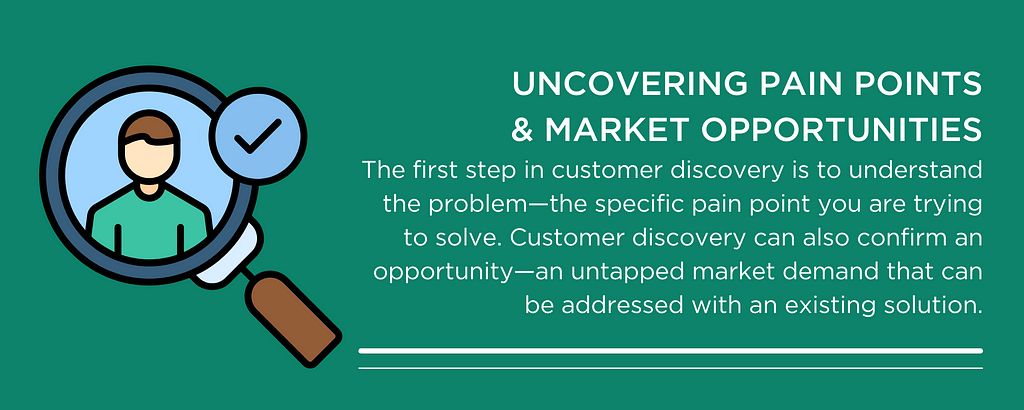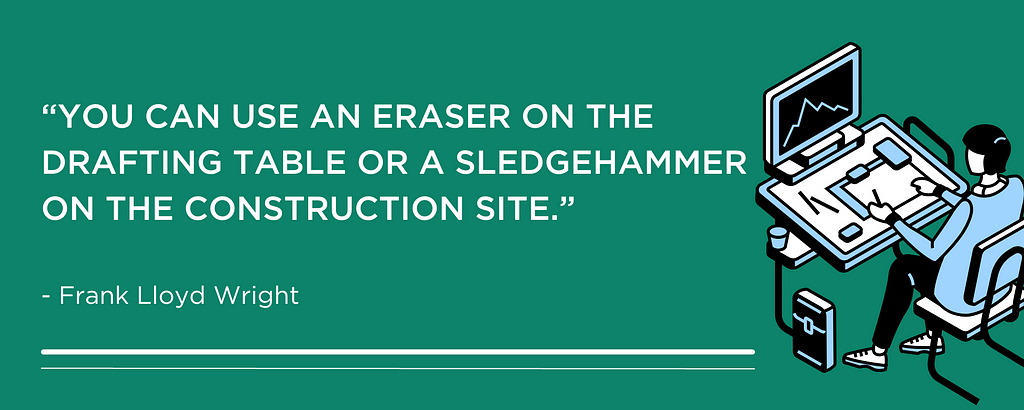The ‘not-so-secret’ code to your entrepreneurial success

Up-Up-Down-Down-Left-Right-Left-Right-B-A. The Konami Code is a series of buttons that many kids growing up in the 80s and 90s had burned into their memory because it unlocks a different bonus feature in over 100 video games.
Extra lives, added time, ultimate power-ups, and hidden levels are just a few of the surprises that this “not-so-secret” secret code reveals.
A similar game-changing tool in the world of entrepreneurship is customer discovery.
Even though it’s no secret that talking to customers is important (and everyone knows about it), customer discovery is often overlooked, put off, or only done once when writing a business plan. But if you want to be in control of the success of your business, then you need to make it an ongoing priority.
Customer discovery is like a turbocharger for startup founders and entrepreneurs! It’s the special combination of activities that propels them forward by helping them understand their target market and customers inside out. This process is all about getting out there and talking directly to potential customers, breaking assumptions, and unleashing the power of feedback.
What is Customer Discovery?
According to Julia Austin of the Harvard Business School, customer discovery “involves defining and prioritizing personas and is applicable to both early-stage companies and big companies when developing new products, seeking to target new personas, or entering new markets.” It’s an iterative process that “should encompass the entire customer journey.”
Imagine you’re in a game where you’re a treasure hunter embarking on a quest to find the legendary chest of gold. Now, think of your customers as the treasure map leading you to that chest. Customer discovery is the process of understanding your customers inside out, their needs, desires, pain points, and aspirations. It involves listening, observing, and engaging with your target audience to gain profound insights that can shape your business strategy.

Know Your Customers, Know Your Business
In today’s fast-paced and highly competitive business landscape, relying on assumptions and guesswork is a recipe for disaster.
Before you even think about creating your business plan or opening a retail space, it’s crucial to validate your idea and ensure it meets a real market need. According to CB Insights, one of the top reasons startups fail (~35% in 2021) is the absence of market demand. Customer discovery is your guiding star, ensuring you don’t fall victim to this all-too-common pitfall. By engaging in customer discovery during the initial phase of your entrepreneurial journey, you can answer critical questions like:
- Is this a big problem that a lot of people have?
- Does the current solution fail to address this problem adequately?
- Am I solving the right problem?
Your mission is to identify if your proposed solution addresses a widespread problem that existing solutions fail to tackle effectively. Customer discovery helps you develop an estimate of the Total Addressable Market (TAM). Your business may address unmet needs, but if the number of customers willing to pay for your solution is too small to generate sustainable revenue, then you need to go back to the drafting table.
Conduct interviews and gather feedback from potential customers to gain insights into their pain points, challenges, and desires. This invaluable information will guide you in refining your value proposition and building a product that customers truly need and are willing to pay for.
There isn’t a magic number for how many interviews you should conduct before moving forward with your idea. For some businesses, it may be 50, but for others, it could 250+. A promising sign that you’ve completed enough interviews is when you stop learning anything new from talking with potential customers.
🕹Cheat Code: This doesn’t mean that you shouldn’t do interviews in the future; it just means that at this time, you’re probably good to move forward with your idea.

An Ongoing Process That Never Ends
Congratulations! You’ve successfully made it to the next level after validating your solution. But the adventure doesn’t end there.
Customer discovery is not a one-time event; it’s an ongoing journey that requires your unwavering attention. Here’s why it should never end:
Validate and Optimize:
As you progress through different business phases, such as customer validation and acquisition, customer discovery continues to play a vital role. It allows you to validate your solution, test your value proposition, and gather critical information to refine your customer profiles.
Stay Relevant & Identify New Opportunities:
New technologies emerge, societal trends shift, and competitors enter the market. Likewise, your customers’ needs, preferences, and pain points can change over time, and staying ahead of the curve is crucial. By continuously talking to and learning from your customers, you can adapt your offerings to meet their evolving expectations. This ensures your business remains relevant in a dynamic market and stays one step ahead of your competitors.
Foster Customer Loyalty:
By consistently seeking customer feedback and incorporating it into your product or service development, you build trust and loyalty. Customers appreciate being heard, and seeing their suggestions implemented strengthens their bond with your brand. Remember, customers are not buying your technology; they are buying a solution to their problem. Be the solution they can’t resist!
Tools and Techniques for Customer Discovery
Now that you’re convinced of the importance of customer discovery, let’s explore some effective tools and techniques to get you started:
1. Surveys and Interviews:
Conducting surveys and interviews with your target audience allows you to gather quantitative and qualitative data. Platforms like Typeform or Google Forms can help streamline this process.
🕹 Cheat Code: Use open-ended questions to illicit insights beyond a simple ‘yes’ or ‘no.’
⭐ ⭐ ⭐ Check out these free customer discovery guide & prototype planning document to help you get started!
2. Focus Groups
Organize focus groups to facilitate in-depth discussions and gain collective insights. Online platforms like Zoom or Slack make it easy to connect with participants remotely.
🕹 Cheat Code: Your goal is to learn NOT to pitch or sell.
3. Social Media Listening
Keep your ear to the ground by monitoring social media conversations related to your industry. Tools like Mention or Hootsuite can assist in tracking discussions and sentiment analysis.
4. Data Analytics
Leverage web analytics tools like Google Analytics to gather data on customer behavior, demographics, and preferences.
5. User Testing
Test your product or service with real customers to gather feedback and identify areas for improvement. Don’t feel like you need to have a perfect, shiny new product for the test. Low-fidelity models work perfectly and are a low-cost way to have customers interact with an actual product or app. Tools like UserTesting or Validately can make your job easier when conducting user tests.
6. Journey Mapping
Journey mapping involves outlining every step of your target persona’s journey, from the initial stages of the purchasing process until the end. These maps enable you to pinpoint major pain points and highlight potential solutions for each one. Like other aspects of discovery, journey mapping is an ongoing, iterative process that never truly concludes.
Customer discovery is not a one-and-done task but rather an exciting expedition that shapes the trajectory of your business. Embrace the power of customer discovery, organize your efforts effectively, and keep your finger on the pulse of your customers so you can adapt to their ever-changing needs.
Remember, your customers hold the key to unlocking the success and longevity of your venture.
And if all else fails, try Up-Up-Down-Down-Left-Right-Left-Right-B-A!
Connect with us
Learn more about Ascender: https://ascenderpgh.com/
Sign up for our newsletter or send us a note: info@ascenderpgh.com
Follow us: Twitter — Facebook — LinkedIn — Instagram
From fledgling tech companies, healthcare innovators, and nonprofits to makers, creators, services and shops, Ascender is for Pittsburgh’s entrepreneurs. We help businesses of all types in the Pittsburgh region start and build a business through education and connectivity. See how Ascender can help you.
Customer Discovery was originally published in Ascender on Medium, where people are continuing the conversation by highlighting and responding to this story.

